Geographical Distribution in Africa
Geographical Distribution of Cutworms in Africa (red marked). Updated 10 July 2019. Source CABI
Cutworms (Agrotis spp.) occur in Africa from the Cape to the Mediterranean Coast. Agrotis ipsilon is one of the most widely distributed species of the cutworm complex. It is generally considered to be worldwide in distribution. Distribution of Agrotis segetum is limited by temperature. In Africa this cutworm is absent in the inner Sahel since the climate is too harsh.
General Information on Pest and Damage
Damage
Young caterpillars feed on leaves and later on stems. Mature caterpillars cause the most damage. They are capable of eating or destroying the entire plant. They girdle and cut-off young seedlings at ground level during the night, dragging them into the tunnel in the soil and feed on them during the day.
- In beans, caterpillars feed on leaves, buds, flowers, and pods. Larger caterpillars tunnel into and destroy the bean pod and seeds.
- In maize, caterpillars will feed on leaves, silk, and ears.
- On tubers and root crops, cutworms feed on tubers and roots, boring a wide shallow hole.
- Thick-stemmed vegetables such as lettuce and brassicasmay have the stem below the ground completely hollowed out. Attacked plant wilt and die.
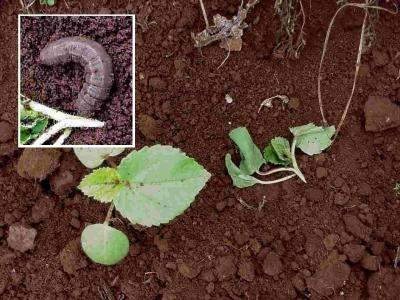 |
| Okra seedling damaged by cutworm caterpillar (right). Note healthy seedling on the left. Close-up of cutworm (inset) |
|
© A.M. Varela, icipe
|
Host Range
Cutworms attack cultivated plants belonging to more than 15 families. Common host plants include okra, cabbage, cauliflower, rutabaga, bell pepper, tomato, potato, maize and cotton.
Symptoms
External feeding on leaves by young caterpillars results in the presence of very tiny round 'window panes'. Feeding on leaves, stalks and stems results in falling leaves, small holes in the stems or cut stems respectively. Feeding on tubers and roots results in a variety of holes, ranging from small and superficial to very large deep ones.
Feeding by medium to large caterpillars is easier to recognise because whole leaves may fall off the plant after being cut through at the base of the stalk. Alternatively, small holes may be found on the stems and roots at the soil surface. A further sign of their activity is the presence of leaf pieces partly pulled down into the soil.
The activity of the fully-grown caterpillars is very obvious. Whole plants fall over and on root crops deep holes become visible at and above the soil surface. Damage to underground tubers (e.g. potatoes) may be difficult to recognise before harvest.
Damage is far more severe under very dry conditions and occurs deeper below the surface (Thygesen, 1971; Esbjerg, 1990).
Affected Plant Stages
Seedling stage and vegetative growing stage.
Affected Plant Parts
Leaves, roots and stems.
Symptoms by affected plant part:
Leaves: "windowpane" holes on leaves; abnormal leaf fall.
Roots: Holes ranging from small and superficial to very large deep ones.
Biology and Ecology of Cutworms
The eggs are ribbed, globular and small (about 0.5 mm in diameter). When newly laid they are cream coloured turning reddish-yellow to blackish before hatching. Eggs are laid singly or in small groups on moist soil, on weeds or on the stem and lower leaves of host plants or on low growing vegetation. A single female may lay up to 2000 eggs. Preferred substrates are densely growing plants relatively low to the ground and fine-textured plant debris in untilled fields. Damp, low-lying areas within untilled fields are particularly attractive for egg-laying moths. Eggs hatch in 10 to 28 days.
Young caterpillars are pale, yellowish-green with a blackish head. Older caterpillars have a plump body; their colour varies from grey, dark green to brown or black with shiny, greasy-looking skin. Fully-grown caterpillars are 4 to 5 cm long. Newly hatched caterpillars feed on the leaves and later on the stems.
Older caterpillars feed at the base of plants or on roots or stems underground. They are nocturnal and hide in the soil or under stones and plant debris during the day. At night they move up to the soil surface to feed. Caterpillars construct burrows or tunnels in the soil about 2.5 to 5 cm deep near the host plant. They pupate in an earthen cell in the soil.
The pupa are about 1.7 to 2.5 cm long, smooth and shiny reddish-brown with two dark spines at the tip of the abdomen. They appear almost black in colour just before the moth emerges.
The adult is a medium-sized moth, about 2 cm long with a wingspan of 4 to 4.5 cm. The forewings are greyish-brown with black lines or kidney-shaped markings along the side margins. The hindwings are pearly white with dark brownish margins and veins. They are active at night.
The life cycle can be completed in 6 weeks under warm conditions.
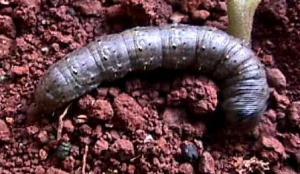 |
| Cutworm (Agrotis sp.) Early instars are about 7-12 mm long. Fully grown caterpillars are 35-50 mm long. |
|
© A.M. Varela, icipe
|
 |
| Black cutworm (Agrotis ipsilon). Pupae are brown to dark brown and approximately 1.7 to 2.5 cm in length and 5 mm in width. |
|
© Courtesy EcoPort (http://www.ecoport.org): P. Ooi
|
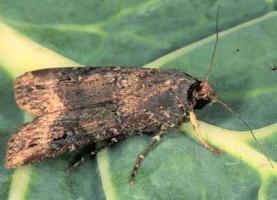 |
| Turnip moth (Agrotis segetum). The adult moth is about 2 cm long and has a wingspan of 4 to 4.5 cm. |
|
© Courtesy EcoPort (http://www.ecoport.org): P. Ooi
|
Pest and Disease Management
Pest and disease Management: General illustration of the concept of Infonet-biovision
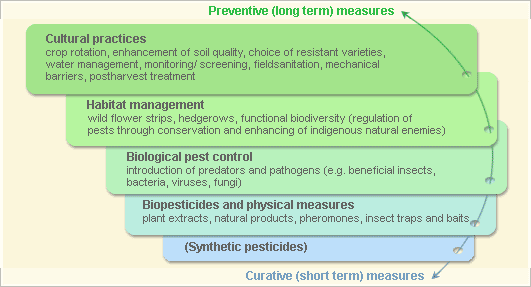
This illustration shows the methods promoted on infonet-biovision. The methods shown at the top have a long-term effect, while methods shown at the bottom have a short-term effect. In organic farming systems, methods with a long-term effect are the basis of crop production and should be used of preference. On the other hand methods with a short-term effect should be used in emergencies only. On infonet we do not promote synthetic pesticides.
Further below you find concrete preventive and curative methods against Cutworms.
Cultural practices
Monitoring and decision making
Early detection helps to prevent serious damage. Check fields for cutworm before sowing or transplanting.
Monitor damage by counting damaged and freshly cut leaves, freshly cut young plants, and holes in leaves and in stems.
Monitoring of cutworm caterpillars should be done at dawn.
Monitoring of cutworm moths can be done by pheromone traps (not available locally).
Control before thinning is advisable where high numbers of cutworms are present. Control is normally not needed when plants are about 25 to 30 cm tall, but heavy attacks can even kill taller plants. Bigger seedlings are more tolerant to damage.
Control options
- Ploughing exposes caterpillars to predators and to desiccation by the sun.
- Fields should be prepared and vegetation and weeds destroyed 10 to 14 days before planting the crop in the field. If the field is planted soon after land preparation some cutworms may be alive and attack the new crop.
- Delaying transplanting slightly until the stems are too wide for the cutworm to encircle and/or too hard for it to cut may reduce cutworm damage.
Hand picking of caterpillars at night by torch or very early morning before they return into the soil is useful at the beginning of the infestation. - Flooding of the field for a few days before sowing or transplanting can help kill cutworm caterpillars in the soil.
Biological pest control
Natural enemies
1. Braconid: Snellenius manilae is a small Braconid wasp species. It looks like Cotesia except that it has a triangular closed cell on its front wing and has hairy eyes. This parasitoid wasp is host specific. It only parasitises cutworm larvae. A female wasp lays 3-5 eggs in a cutworm larva. The parasite eats the body fluids and the larva for its development. Cocoons are formed next to the host's body. Lifecycle takes about 4-8 days. A wasp lives for about 1 week.
2. Cotesiaspp
3. Tachinid fly
For more information on natural enemies click here.
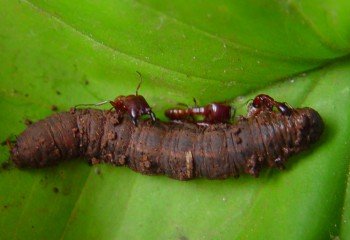
Biopesticides and physical methods
Neem (Azadirachta indica)
Experiments in Sudan showed that spraying aqueous neem seed and neem leaf extracts 3 times at weekly intervals, starting directly after tuberisation reduced early infestation by cutworms on potato leaves. To prepare the extracts, leaf and seed powder were soaked in water at a rate of 1kg/40 l of water, stirred thoroughly and left overnight, and passed through a sieve before spraying (Siddig,1987).
For information on Neem click here.
Bait traps
How to make baits:
1. Mix 100 g bran or maize flour, 10 g sugar (1 small tablespoon), 5 g pyrethrum powder with 200 ml water thoroughly together.
2. Sprinkle mixture closely around the plants in the affected areas.
The cutworms will eat the bait and die.
or
1. Mix equal quantities of hardwood sawdust, bran and molasses with enough water to make the mixture sticky.
2. Spread around the plants in the evenings.
The bait attracts the cutworms and as they try to pass through it they get stuck and die.
Pheromone traps
Pheromone traps are used to monitor and catch moths of cutworms. However, pheromones for cutworms are not available in the region.
How to make:
1. Make 10 to 12 holes into 1 liter plastic bottle or 3 holes on each side of 1 liter ice cream container, to allow moths to enter.
2. Heat a small piece of metal to make the holes easily.
3. Put a wire from the cover to suspend the bait.
4. Secure the pheromone dispenser aligns with the entrance holes inside the trap.
5. Make a rectangular opening into the lower part of the container for removing the moths caught.
How to use?
1. Half-fill the trap with soapy water.
2. Put bait in the pheromone dispenser or suspend the pheromone capsule from the lid using string or wire. 3. Close the container.
4. Attach the trap to a bamboo or wooden stake or hang on branch of a tree.
5. Place traps for different pests at least 3 meters apart. If traps are used for monitoring the pests, 2-3 traps are enough for 1 ha field.
Reminders while using pheromone traps:
- Buy the pheromone that lures the pest you want to control.
- Always label the trap. The name of the species you are trapping, the date the bait was placed, and the name of the bait if you are using several.
- Change bait according to manufacturer's recommendation.
- Dispose properly the bait wrappers. The tiny amount of pheromone left near the traps will compete with your bait.
- Wash your hands between handling baits. Minute traces of other chemicals can render the baits completely ineffective.
- Always remove all captured adults during each visit. Discard them away from the field. Put live ones into a bucket with soap solution to drown
Protective collars
Protective collars made of plastic or paper cups, cardboard tubes from paper towels or toilet paper, plastic drink bottles with ripped-out bottom, sturdy cardboard, and milk cartons. Place the collar around the young plant just after planting and push into the soil to prevent the cutworm from attacking the stem.
Sticky substances
Such as molasses, diatomite earth, saw dust, or crushed eggshells placed around the base of each plant. When cutworm emerges to feed, it will come in contact with the trap, get stuck, harden, and die.
Ashes
Ashes are reported to deter cutworms when spread on seedbeds, around plants, or mixed with the soil in the planting holes. The ash layer must be renewed repeatedly.
Stick
A thick dry stick inserted on the side of the seedlings can act as a mechanical barrier, reducing loss of plants by cutworms.
Information Source Links
- CABI (2005). Crop Protection Compendium, 2005 Edition. © CAB International Publishing. Wallingford, UK. www.cabi.org
- Elwell, H. and Mass, A. (1995). Natural Pest and Disease Control. Published by the Natural Farming Network. Harare, Zimbabwe.
- Esbjerg, P. (1990). The significance of shelter for young cutworms (Agrotis segetum). Entomologia Experimentalis et Applicata, 54(2):97-100.
- Hill, S. D. (1983). Agricultural insect pests of the tropics and their control. Second edition. Cambridge University Press. ISBN: 0-521-24638-5
- OISAT: Organisation for Non-Chemical Pest Management in the Tropics www.oisat.org
- Seif, A.A., Varela, A. M., Michalik, S. and Löhr, B. (2001). A Guide to IPM in French beans production with emphasis on Kenya. ICIPE Science Press. ISBN: 92-9064-142-8
- Siddig, S. A. (1987). A proposed pest management program including neem treatments for combating potato pests in the Sudan. Proc. 3rd Int. Neem Conf. (Nairobi, Kenya, 1986). pp. 449-459.
- Thygesen, Th. (1971). On the correlation between cutworm attacks, light trapping and weather conditions. Danish Journal of Plant and Soil Science, 75:807-815.
- Varela, A. M. and Seif, A.A. (2004). A Guide to IPM and Hygiene Standards in Okra Production in Kenya. ICIPE Science Press. ISBN: 92-9064-161-5.
